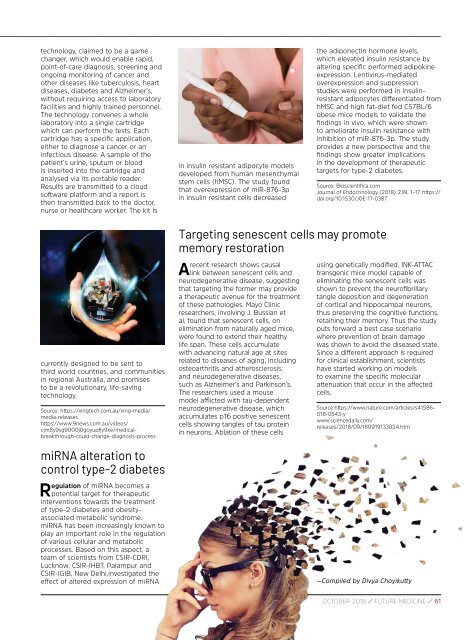You also want an ePaper? Increase the reach of your titles
YUMPU automatically turns print PDFs into web optimized ePapers that Google loves.
technology, claimed to be a game<br />
changer, which would enable rapid,<br />
point-of-care diagnosis, screening and<br />
ongoing monitoring of cancer and<br />
other diseases like tuberculosis, heart<br />
diseases, diabetes and Alzheimer’s,<br />
without requiring access to laboratory<br />
facilities and highly trained personnel.<br />
The technology convenes a whole<br />
laboratory into a single cartridge<br />
which can perform the tests. Each<br />
cartridge has a specific application,<br />
either to diagnose a cancer or an<br />
infectious disease. A sample of the<br />
patient’s urine, sputum or blood<br />
is inserted into the cartridge and<br />
analysed via its portable reader.<br />
Results are transmitted to a cloud<br />
software platform and a report is<br />
then transmitted back to the doctor,<br />
nurse or healthcare worker. The kit is<br />
in insulin resistant adipocyte models<br />
developed from human mesenchymal<br />
stem cells (hMSC). The study found<br />
that overexpression of miR-876-3p<br />
in insulin resistant cells decreased<br />
the adiponectin hormone levels,<br />
which elevated insulin resistance by<br />
altering specific performed adipokine<br />
expression. Lentivirus-mediated<br />
overexpression and suppression<br />
studies were performed in insulinresistant<br />
adipocytes differentiated from<br />
hMSC and high fat-diet fed C57BL/6<br />
obese mice models to validate the<br />
findings in vivo, which were shown<br />
to ameliorate insulin resistance with<br />
inhibition of miR-876-3p. The study<br />
provides a new perspective and the<br />
findings show greater implications<br />
in the development of therapeutic<br />
targets for type-2 diabetes.<br />
Source: Bioscientifica.com<br />
Journal of Endocrinology (<strong>2018</strong>) 239, 1–17 https://<br />
doi.org/10.1530/JOE-17-0387<br />
currently designed to be sent to<br />
third world countries, and communities<br />
in regional Australia, and promises<br />
to be a revolutionary, life-saving<br />
technology.<br />
Source: https://xingtech.com.au/xing-media/<br />
media-releases<br />
https://www.9news.com.au/videos/<br />
cjm8y9sg9000j0goyupfjy9xe/medicalbreakthrough-could-change-diagnosis-process<br />
miRNA alteration to<br />
control type-2 diabetes<br />
Regulation of miRNA becomes a<br />
potential target for therapeutic<br />
interventions towards the treatment<br />
of type-2 diabetes and obesityassociated<br />
metabolic syndrome.<br />
miRNA has been increasingly known to<br />
play an important role in the regulation<br />
of various cellular and metabolic<br />
processes. Based on this aspect, a<br />
team of scientists from CSIR-CDRI,<br />
Lucknow, CSIR-IHBT, Palampur and<br />
CSIR-IGIB, New Delhi,investigated the<br />
effect of altered expression of miRNA<br />
Targeting senescent cells may promote<br />
memory restoration<br />
recent research shows causal<br />
A link between senescent cells and<br />
neurodegenerative disease, suggesting<br />
that targeting the former may provide<br />
a therapeutic avenue for the treatment<br />
of these pathologies. Mayo Clinic<br />
researchers, involving J. Bussian et<br />
al, found that senescent cells, on<br />
elimination from naturally aged mice,<br />
were found to extend their healthy<br />
life span. These cells accumulate<br />
with advancing natural age at sites<br />
related to diseases of aging, including<br />
osteoarthritis and atherosclerosis;<br />
and neurodegenerative diseases,<br />
such as Alzheimer’s and Parkinson’s.<br />
The researchers used a mouse<br />
model afflicted with tau-dependent<br />
neurodegenerative disease, which<br />
accumulates p16 positive senescent<br />
cells showing tangles of tau protein<br />
in neurons. Ablation of these cells<br />
using genetically modified, INK-ATTAC<br />
transgenic mice model capable of<br />
eliminating the senescent cells was<br />
shown to prevent the neurofibrillary<br />
tangle deposition and degeneration<br />
of cortical and hippocampal neurons,<br />
thus preserving the cognitive functions,<br />
retaining their memory. Thus the study<br />
puts forward a best case scenario<br />
where prevention of brain damage<br />
was shown to avoid the diseased state.<br />
Since a different approach is required<br />
for clinical establishment, scientists<br />
have started working on models<br />
to examine the specific molecular<br />
attenuation that occur in the affected<br />
cells.<br />
Source:https://www.nature.com/articles/s41586-<br />
018-0543-y<br />
www.sciencedaily.com/<br />
releases/<strong>2018</strong>/09/180919133024.htm<br />
—Compiled by Divya Choyikutty<br />
<strong>OCTOBER</strong> <strong>2018</strong> / FUTURE MEDICINE / 61


















